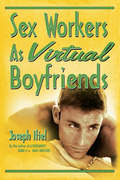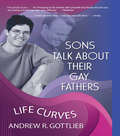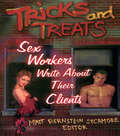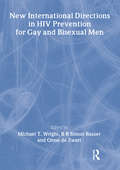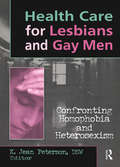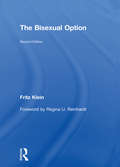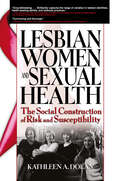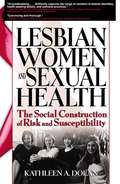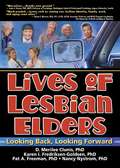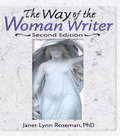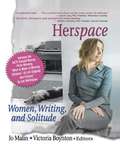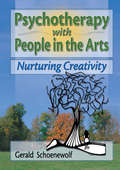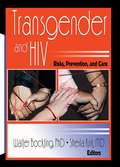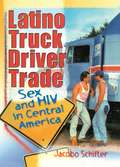- Table View
- List View
Sex Workers As Virtual Boyfriends
by Joseph ItielBeyond lust, create companionship with your sex workers!Many more men are willing to buy sex than to admit the fact. Joseph Itiel is not only willing to admit it--he has the courage and style to create “virtual” relationships with hustlers. These ongoing professional relationships are a step beyond cold, anonymous sex for sale. Though the economic basis remains the same--an open exchange of cash for sex--the association is also honest, affectionate, and sexually fulfilling. He explains how you can do the same in Sex Workers as Virtual Boyfriends, a companion volume to his best-selling A Consumer's Guide to Male Hustlers (Haworth 1998).From his own experience, stretching over four decades and many nations, the author suggests ways to transform the relationship between a client and his escort from a crass commercial transaction to a true camaraderie. Sex Workers as Virtual Boyfriends also offers an intimate glimpse into the gay lifestyle in San Francisco and around the world before the AIDS epidemic and in these days of safer sex. Sex Workers as Virtual Boyfriends presents practical tips and real-life vignettes, including: an experiment to help you decide if you could be a sex worker (See if you measure up!) an appendix containing a comprehensive list of sex workers advertising on the World Wide Web seven guidelines for friendly relations with your escort a guide to the etiquette of negotiable affectionSex Workers as Virtual Boyfriends is shocking, sexy, literate, and fun. It also can help you find the affection you want--at a price you can afford.
Sex Workers As Virtual Boyfriends
by Joseph ItielBeyond lust, create companionship with your sex workers!Many more men are willing to buy sex than to admit the fact. Joseph Itiel is not only willing to admit it--he has the courage and style to create “virtual” relationships with hustlers. These ongoing professional relationships are a step beyond cold, anonymous sex for sale. Though the economic basis remains the same--an open exchange of cash for sex--the association is also honest, affectionate, and sexually fulfilling. He explains how you can do the same in Sex Workers as Virtual Boyfriends, a companion volume to his best-selling A Consumer's Guide to Male Hustlers (Haworth 1998).From his own experience, stretching over four decades and many nations, the author suggests ways to transform the relationship between a client and his escort from a crass commercial transaction to a true camaraderie. Sex Workers as Virtual Boyfriends also offers an intimate glimpse into the gay lifestyle in San Francisco and around the world before the AIDS epidemic and in these days of safer sex. Sex Workers as Virtual Boyfriends presents practical tips and real-life vignettes, including: an experiment to help you decide if you could be a sex worker (See if you measure up!) an appendix containing a comprehensive list of sex workers advertising on the World Wide Web seven guidelines for friendly relations with your escort a guide to the etiquette of negotiable affectionSex Workers as Virtual Boyfriends is shocking, sexy, literate, and fun. It also can help you find the affection you want--at a price you can afford.
Sons Talk About Their Gay Fathers: Life Curves
by Andrew GottliebExamine the impact of disclosure on sons whose fathers are gay! In this book, Andrew Gottlieb, author of Out of the Twilight: Fathers of Gay Men Speak, explores yet another side of the impact of homosexuality on families. He now looks at how sons react to learning that their fathers are gay, allowing us to see, over time, how this has changed their family relationships and their own lives. Simply and elegantly written, this psychoanalytically oriented qualitative research study is accessible to both the beginner and the more advanced researcher and practitioner. It draws from a wide range of literary, popular, and psychological sources and includes an interview guide, a reference section, and an index. "When someone discloses as gay, lesbian, or bisexual, it is not just an individual event. It is a family event. Based on estimates of married gay, lesbian, and bisexual persons, a spouse's coming out affects up to 2,000,000 couples. Yet, its impact has been largely ignored. Children&’s voices are the least often heard. . . . Little has been written about sons of fathers who came out during or after marriage. Data for studies that do exist most often draw from the fathers' point of view. . . . The significance of this study lies in its comprehensive, detailed picture of sons and gay fathers as they develop their separate self-images as well as the images of their son-father relationships over time. Painful, sensitive, often triumphant, the stories and [the author&’s] analysis of their thoughts, perceptions, and feelings afford a multidimensional, longitudinal viewing. Step by step, we follow the complicated dance of these sons and fathers as they develop and define their connection." -from the Foreword by Amity Pierce Buxton, Author of The Other Side of the Closet: The Coming-Out Crisis for Straight Spouses and Families Sons Talk About Their Gay Fathers: Life Curves is a storybook-an extended narrative moved along, but not overshadowed, by psychoanalytic theory. The Introduction briefly reviews more recent writings of the fathering experience as told by gay men themselves, setting the stage for: "Father to Child"-a look at the father as seen through the ever-shifting eyes of his son at different phases of the life cycle "The Quest for the Real Father"-an examination of sons' responses to their fathers' homosexuality as captured in film, fiction, nonfiction, television, and the psychological literature "Methodology"-the story of the research process, including sampling, the search for subjects, trustworthiness, the interview, bias, and data collection "The Stories"-an anthology of narratives the author constructed from the interview material, painting an intimate portrait of each individual son "Findings"-a categorical analysis "Discussion"-a summary of all the preceding material cast in a developmental framework, highlighting implications for future research and clinical practice
Sons Talk About Their Gay Fathers: Life Curves
by Andrew GottliebExamine the impact of disclosure on sons whose fathers are gay! In this book, Andrew Gottlieb, author of Out of the Twilight: Fathers of Gay Men Speak, explores yet another side of the impact of homosexuality on families. He now looks at how sons react to learning that their fathers are gay, allowing us to see, over time, how this has changed their family relationships and their own lives. Simply and elegantly written, this psychoanalytically oriented qualitative research study is accessible to both the beginner and the more advanced researcher and practitioner. It draws from a wide range of literary, popular, and psychological sources and includes an interview guide, a reference section, and an index. "When someone discloses as gay, lesbian, or bisexual, it is not just an individual event. It is a family event. Based on estimates of married gay, lesbian, and bisexual persons, a spouse's coming out affects up to 2,000,000 couples. Yet, its impact has been largely ignored. Children&’s voices are the least often heard. . . . Little has been written about sons of fathers who came out during or after marriage. Data for studies that do exist most often draw from the fathers' point of view. . . . The significance of this study lies in its comprehensive, detailed picture of sons and gay fathers as they develop their separate self-images as well as the images of their son-father relationships over time. Painful, sensitive, often triumphant, the stories and [the author&’s] analysis of their thoughts, perceptions, and feelings afford a multidimensional, longitudinal viewing. Step by step, we follow the complicated dance of these sons and fathers as they develop and define their connection." -from the Foreword by Amity Pierce Buxton, Author of The Other Side of the Closet: The Coming-Out Crisis for Straight Spouses and Families Sons Talk About Their Gay Fathers: Life Curves is a storybook-an extended narrative moved along, but not overshadowed, by psychoanalytic theory. The Introduction briefly reviews more recent writings of the fathering experience as told by gay men themselves, setting the stage for: "Father to Child"-a look at the father as seen through the ever-shifting eyes of his son at different phases of the life cycle "The Quest for the Real Father"-an examination of sons' responses to their fathers' homosexuality as captured in film, fiction, nonfiction, television, and the psychological literature "Methodology"-the story of the research process, including sampling, the search for subjects, trustworthiness, the interview, bias, and data collection "The Stories"-an anthology of narratives the author constructed from the interview material, painting an intimate portrait of each individual son "Findings"-a categorical analysis "Discussion"-a summary of all the preceding material cast in a developmental framework, highlighting implications for future research and clinical practice
Tricks and Treats: Sex Workers Write About Their Clients
by Matt Bernstein SycamoreLearn about the real lives of sex workers by exploring the sex industry from the inside!Explore the insightful--and oftentimes intense--accounts of sex workers who look squarely into the eyes of their clients, the sex industry, and society as a whole. Tricks and Treats delivers private stories about homo- and heterosexual encounters that sex workers usually confide only in each other. Not another “why I became a prostitute” book, it provocatively turns the tables on the buyers of sex, giving you a window into sex workers’lives. Tricks and Treats gives you straightforward accounts by sex workers to help you understand the pleasures, attractions, and truths of this profession. Tricks and Treats tantalizes with its powerful collection of tales from a diverse group of male, female, and transgendered sex workers. Their commercial, cultural, emotional, sexual, (il)legal, and even spiritual relationships with their clients are discussed in intimate detail. You will explore accounts from streetworkers, escorts, strippers, porn actors, masseurs, dominatrixes, phone sex operators, an adult-video store clerk, an outreach worker, a sex educator, and even a sperm donor.Tricks and Treats will ignite your imagination and answer questions few people dare to ask. You'll learn firsthand, of: how male, female, and transgendered hustlers turn tricks--in their own words--from sado-masochism and watersports to stripping, scat, foreplay, and fisting how sex workers face their own mortality when confronted with the AIDS virus a porn star's compassion and understanding for her fans a sex worker's coming-to-terms with his/her transgendered identity a male escort's attempts at dating a young man's experience of finding a family and home when living at a brothel a woman's story of spending thirty years as a prostitute the experiences of hooking on the streets and in clubs, cafes, and homesThese engaging and shocking testimonials will entertain you and offer a unique understanding of the sex industry. Revealing and intriguing, these poignant talks will certainly not disappoint your imagination. Tricks and Treats is a testament to the lives of sex workers, a manifestation of their spirit, and gives them a chance to turn the tables on their clients, exposing their erotic tastes, turn-ons, and fantasies.
Tricks and Treats: Sex Workers Write About Their Clients
by Matt Bernstein SycamoreLearn about the real lives of sex workers by exploring the sex industry from the inside!Explore the insightful--and oftentimes intense--accounts of sex workers who look squarely into the eyes of their clients, the sex industry, and society as a whole. Tricks and Treats delivers private stories about homo- and heterosexual encounters that sex workers usually confide only in each other. Not another “why I became a prostitute” book, it provocatively turns the tables on the buyers of sex, giving you a window into sex workers’lives. Tricks and Treats gives you straightforward accounts by sex workers to help you understand the pleasures, attractions, and truths of this profession. Tricks and Treats tantalizes with its powerful collection of tales from a diverse group of male, female, and transgendered sex workers. Their commercial, cultural, emotional, sexual, (il)legal, and even spiritual relationships with their clients are discussed in intimate detail. You will explore accounts from streetworkers, escorts, strippers, porn actors, masseurs, dominatrixes, phone sex operators, an adult-video store clerk, an outreach worker, a sex educator, and even a sperm donor.Tricks and Treats will ignite your imagination and answer questions few people dare to ask. You'll learn firsthand, of: how male, female, and transgendered hustlers turn tricks--in their own words--from sado-masochism and watersports to stripping, scat, foreplay, and fisting how sex workers face their own mortality when confronted with the AIDS virus a porn star's compassion and understanding for her fans a sex worker's coming-to-terms with his/her transgendered identity a male escort's attempts at dating a young man's experience of finding a family and home when living at a brothel a woman's story of spending thirty years as a prostitute the experiences of hooking on the streets and in clubs, cafes, and homesThese engaging and shocking testimonials will entertain you and offer a unique understanding of the sex industry. Revealing and intriguing, these poignant talks will certainly not disappoint your imagination. Tricks and Treats is a testament to the lives of sex workers, a manifestation of their spirit, and gives them a chance to turn the tables on their clients, exposing their erotic tastes, turn-ons, and fantasies.
New International Directions in HIV Prevention for Gay and Bisexual Men
by Michael Wright B R RosserIt is widely recognized that current HIV intervention models are falling short of their goals. What are the alternatives?To answer this question, New International Directions in HIV Prevention for Gay and Bisexual Men presents a collection of articles from European and American authors that rival dominant paradigms of HIV prevention. Researchers, practitioners, and community organizations will be challenged to examine current assumptions and to consider neglected aspects of risk behavior such as love, trust, and the dynamics of sexual intimacy. New International Directions in HIV Prevention for Gay and Bisexual Men explores models and theories that will help you develop more effective HIV prevention programs to better serve patients and clients.New International Directions in HIV Prevention for Gay and Bisexual Men offers you fresh perspectives on prevention work by examining risk behaviors in the interactional, communal, and social contexts in which they are practiced. You will receive alternative explanations and reasons for HIV risk that go beyond current approaches and that introduce possibilities for new intervention strategies. Written by experts in the field, the chapters in New International Directions in HIV Prevention for Gay and Bisexual Men will give you insight into new ideas and developments, including: placing a greater emphasis on improving successful risk management strategies as opposed to quantifying risk factors examining the meaning and context of sexual acts which occur in casual encounters or steady partnerships and incorporating their relevancy into prevention work considering the effects that cultural context and socially constructed meanings have on prevention work and incorporating individuals’values and feelings into prevention strategies focusing on more realistic goals of harm reduction that take sexual decision making into consideration as opposed to expecting abstinence relating the various aspects of sexual encounters--physical attraction, intimacy, reciprocity, and power--to reasons why men choose not to use condomsExamining how gay men can underestimate the risk of HIV in order to meet needs of intimacy, New International Directions in HIV Prevention for Gay and Bisexual Men will help you understand the symbolic dimension of sexual contact. The normal, everyday reasons for having sex without a condom are explored, questioning models which often characterize unprotected sex as being the result of low self-esteem, substance abuse, or some other psychological vulnerability. Presenting data from both qualitative and quantitative research conducted at group and individual levels, this book reveals the complexity of risk behavior, the richness of sexual experience, and the importance of respecting the unique context in which gay men live their sexual lives. New International Directions in HIV Prevention for Gay and Bisexual Men will help you understand this point of view, enabling you to provide patients and clients with more effective HIV prevention and risk management services.
New International Directions in HIV Prevention for Gay and Bisexual Men
by Michael Wright B R RosserIt is widely recognized that current HIV intervention models are falling short of their goals. What are the alternatives?To answer this question, New International Directions in HIV Prevention for Gay and Bisexual Men presents a collection of articles from European and American authors that rival dominant paradigms of HIV prevention. Researchers, practitioners, and community organizations will be challenged to examine current assumptions and to consider neglected aspects of risk behavior such as love, trust, and the dynamics of sexual intimacy. New International Directions in HIV Prevention for Gay and Bisexual Men explores models and theories that will help you develop more effective HIV prevention programs to better serve patients and clients.New International Directions in HIV Prevention for Gay and Bisexual Men offers you fresh perspectives on prevention work by examining risk behaviors in the interactional, communal, and social contexts in which they are practiced. You will receive alternative explanations and reasons for HIV risk that go beyond current approaches and that introduce possibilities for new intervention strategies. Written by experts in the field, the chapters in New International Directions in HIV Prevention for Gay and Bisexual Men will give you insight into new ideas and developments, including: placing a greater emphasis on improving successful risk management strategies as opposed to quantifying risk factors examining the meaning and context of sexual acts which occur in casual encounters or steady partnerships and incorporating their relevancy into prevention work considering the effects that cultural context and socially constructed meanings have on prevention work and incorporating individuals’values and feelings into prevention strategies focusing on more realistic goals of harm reduction that take sexual decision making into consideration as opposed to expecting abstinence relating the various aspects of sexual encounters--physical attraction, intimacy, reciprocity, and power--to reasons why men choose not to use condomsExamining how gay men can underestimate the risk of HIV in order to meet needs of intimacy, New International Directions in HIV Prevention for Gay and Bisexual Men will help you understand the symbolic dimension of sexual contact. The normal, everyday reasons for having sex without a condom are explored, questioning models which often characterize unprotected sex as being the result of low self-esteem, substance abuse, or some other psychological vulnerability. Presenting data from both qualitative and quantitative research conducted at group and individual levels, this book reveals the complexity of risk behavior, the richness of sexual experience, and the importance of respecting the unique context in which gay men live their sexual lives. New International Directions in HIV Prevention for Gay and Bisexual Men will help you understand this point of view, enabling you to provide patients and clients with more effective HIV prevention and risk management services.
Health Care for Lesbians and Gay Men: Confronting Homophobia and Heterosexism
by K Jean PetersonHealth Care for Lesbians and Gay Men educates practitioners about the special needs of gay and lesbian patients and how to look critically at the impact of homophobia and heterosexism on the provision of care. It provides an overview of critical health care issues for lesbians and gay men and offers concrete suggestions to health practitioners and social workers on how to address these issues in order to guarantee the best care for their patients and clients. Authors in Health Care for Lesbians and Gay Men give health care providers and mental health workers practical interventions; suggestions for advocacy, social change, grassroots efforts, and alternative programs; and lessons about how to use existing procedures to more effectively meet the unique health care needs of gays and lesbians. Practitioners also learn how to utilize legal action in securing and protecting patients’and clients’personal health care wishes. Chapters in this book cover: how homophobia and negative attitudes can directly compromise the care given to lesbians and gay men. heterosexism and biases which exclude the partners of gay men and lesbians from participating in the care of their loved ones. legal issues and the need for legal recognition of gay and lesbian relationships, both to enhance the provision of care and for financial access to health care presently available to only heterosexual, married couples. legal protection and special legal documents that ensure that the wishes of gay men and lesbians are honored and the integrity of their relationships not violated.Health Care for Lesbians and Gay Men starts with special issues confronting adolescents and the special role health care providers can play in supporting the struggles of lesbian and gay adolescents. It then continues to look at these issues over the life cycle. Three themes emerge as authors try to explain problems and possible solutions for lesbians and gay men seeking health care: the pervasive homophobia and heterosexism found throughout the health care system and the impact these attitudes and beliefs have on the health care of lesbians and gay men; the need for education in professional programs on special health issues of gay men and lesbians; and the critical role that social workers can play in both educating others about the special needs of their gay and lesbian clients and in advocating for their clients in various health care settings.Health Care for Lesbians and Gay Men is essential reading for social work and social service practitioners and students working in the health care field, advanced undergraduates and graduate students of social work, professionals and students of nursing and medicine, and others concerned with the quality and equality of health care services. It urges students and professionals to challenge and evaluate their own attitudes, beliefs, and behaviors in order to ensure quality services to all clients and patients.
Health Care for Lesbians and Gay Men: Confronting Homophobia and Heterosexism
by K Jean PetersonHealth Care for Lesbians and Gay Men educates practitioners about the special needs of gay and lesbian patients and how to look critically at the impact of homophobia and heterosexism on the provision of care. It provides an overview of critical health care issues for lesbians and gay men and offers concrete suggestions to health practitioners and social workers on how to address these issues in order to guarantee the best care for their patients and clients. Authors in Health Care for Lesbians and Gay Men give health care providers and mental health workers practical interventions; suggestions for advocacy, social change, grassroots efforts, and alternative programs; and lessons about how to use existing procedures to more effectively meet the unique health care needs of gays and lesbians. Practitioners also learn how to utilize legal action in securing and protecting patients’and clients’personal health care wishes. Chapters in this book cover: how homophobia and negative attitudes can directly compromise the care given to lesbians and gay men. heterosexism and biases which exclude the partners of gay men and lesbians from participating in the care of their loved ones. legal issues and the need for legal recognition of gay and lesbian relationships, both to enhance the provision of care and for financial access to health care presently available to only heterosexual, married couples. legal protection and special legal documents that ensure that the wishes of gay men and lesbians are honored and the integrity of their relationships not violated.Health Care for Lesbians and Gay Men starts with special issues confronting adolescents and the special role health care providers can play in supporting the struggles of lesbian and gay adolescents. It then continues to look at these issues over the life cycle. Three themes emerge as authors try to explain problems and possible solutions for lesbians and gay men seeking health care: the pervasive homophobia and heterosexism found throughout the health care system and the impact these attitudes and beliefs have on the health care of lesbians and gay men; the need for education in professional programs on special health issues of gay men and lesbians; and the critical role that social workers can play in both educating others about the special needs of their gay and lesbian clients and in advocating for their clients in various health care settings.Health Care for Lesbians and Gay Men is essential reading for social work and social service practitioners and students working in the health care field, advanced undergraduates and graduate students of social work, professionals and students of nursing and medicine, and others concerned with the quality and equality of health care services. It urges students and professionals to challenge and evaluate their own attitudes, beliefs, and behaviors in order to ensure quality services to all clients and patients.
The Bisexual Option: Second Edition
by Fritz KleinSoon to be translated into Japanese! The Bisexual Option explores bisexuality, explains the bisexual, and explodes myths surrounding this large “unseen” segment of the population. Now in its second edition, this intriguing book gives an overview of bisexuality. As there is still no book that covers the subject like this one, it is must reading for establishing a contemporary view of bisexuality and those committed to a bisexual lifestyle. Fritz Klein, an experienced psychiatrist and expert in bisexuality and sexual orientation, explains the concept and the variables of sexual orientation and where bisexuality fits.He covers many subjects in the book including: myths of bisexual nonexistence and the “either/or” dilemma intimacy, both emotional and sexual an explanation of bisexuality and the Oedipus Complex definitions and examples of the healthy and troubled bisexual major sociological findings about bisexuality the bisexual in history the bisexual as depicted in the arts factors that will influence bisexuality in the futureThe book helps readers understand where they fit on the sexual orientation continuum. The Bisexual Option aids in explaining who bisexuals are and why they have problems in heterosexual as well as homosexual societies and shows bisexuals that they are not alone. Even helping professionals will find information on this “invisible” but large segment of the population.A variety of readers will want to read The Bisexual Option including the bisexual community and individual bisexuals, the homosexual communities which include many bisexuals, mental health practitioners, psychologists, both students and professionals, university students, married partners of bisexuals, HIV/AIDS workers who wish to become acquainted with how bisexuality affects the risk to the heterosexual community, sexologists, and researchers.
The Bisexual Option: Second Edition
by Fritz KleinSoon to be translated into Japanese! The Bisexual Option explores bisexuality, explains the bisexual, and explodes myths surrounding this large “unseen” segment of the population. Now in its second edition, this intriguing book gives an overview of bisexuality. As there is still no book that covers the subject like this one, it is must reading for establishing a contemporary view of bisexuality and those committed to a bisexual lifestyle. Fritz Klein, an experienced psychiatrist and expert in bisexuality and sexual orientation, explains the concept and the variables of sexual orientation and where bisexuality fits.He covers many subjects in the book including: myths of bisexual nonexistence and the “either/or” dilemma intimacy, both emotional and sexual an explanation of bisexuality and the Oedipus Complex definitions and examples of the healthy and troubled bisexual major sociological findings about bisexuality the bisexual in history the bisexual as depicted in the arts factors that will influence bisexuality in the futureThe book helps readers understand where they fit on the sexual orientation continuum. The Bisexual Option aids in explaining who bisexuals are and why they have problems in heterosexual as well as homosexual societies and shows bisexuals that they are not alone. Even helping professionals will find information on this “invisible” but large segment of the population.A variety of readers will want to read The Bisexual Option including the bisexual community and individual bisexuals, the homosexual communities which include many bisexuals, mental health practitioners, psychologists, both students and professionals, university students, married partners of bisexuals, HIV/AIDS workers who wish to become acquainted with how bisexuality affects the risk to the heterosexual community, sexologists, and researchers.
Lesbian Women and Sexual Health: The Social Construction of Risk and Susceptibility
by R Dennis Shelby Kathleen DolanInterviewer: Where did you find out how to have safe lesbian sex?Val: I found out in jail.Why do so many lesbian women engage in sexual behavior that puts their health, even their lives, at risk? Many know they&’re at risk, yet somehow feel safe enough to behave as if there is no reason to practice safe sex. Lesbian Women and Sexual Health: The Social Construction of Risk and Susceptibility examines how lesbian women perceive their level of risk for HIV and other sexually transmitted infections (STIs). It describes how their perceptions of risk and susceptibility are shaped by factors such as sexual identity, cultural themes, and community knowledge-and how those perceptions impact on the very real HIV/STI risks that lesbian women face. The genesis of Lesbian Women and Sexual Health: The Social Construction of Risk and Susceptibility lies in Kathleen Dolan&’s exploratory study of this under-researched area, in which 162 structured interviews and 70 in-depth interviews were conducted with women who self-identify as lesbians. What these women have to say will inform, educate, and probably surprise you. Tables and figures make complex data easy to access and understand.Lesbian women construct and label their identities and actions in complex ways that may lead to risky behavior. In the words of the women surveyed-and in Dr. Dolan&’s insightful commentary-this book explores the ways in which lesbian women construct their perceptions of risk and susceptibility to seek answers to questions that include: Do many lesbian women see themselves, to an extent, as immune to HIV contraction? How does their self-constructed sense of risk and susceptibility lead to making dangerous choices? Why, in spite of their professed willingness to engage in protective actions, do many lesbians not actually do so? Why do many lesbian women, and some of the health care professionals who serve them, feel that pap smears are not necessary for women who have sex only with other women-and what are the consequences of this opinion? What is the relationship between drug/alcohol use and risky sexual behaviors in lesbian women?Lesbian Women and Sexual Health: The Social Construction of Risk and Susceptibility is an important resource for women&’s/lesbian health advocates, health care professionals, and courses in gay/women&’s/medical studies. It addresses gaps in the existing research to enhance our understanding of the physical and mental health status of lesbian women, of risk factors and protective actions regarding HIV and STIs, and of the conditions for which protective actions actually reduce risk. Use it to update your knowledge of this under-studied area at the intersection of physical, emotional, and sexual health.
Lesbian Women and Sexual Health: The Social Construction of Risk and Susceptibility
by R Dennis Shelby Kathleen DolanInterviewer: Where did you find out how to have safe lesbian sex?Val: I found out in jail.Why do so many lesbian women engage in sexual behavior that puts their health, even their lives, at risk? Many know they&’re at risk, yet somehow feel safe enough to behave as if there is no reason to practice safe sex. Lesbian Women and Sexual Health: The Social Construction of Risk and Susceptibility examines how lesbian women perceive their level of risk for HIV and other sexually transmitted infections (STIs). It describes how their perceptions of risk and susceptibility are shaped by factors such as sexual identity, cultural themes, and community knowledge-and how those perceptions impact on the very real HIV/STI risks that lesbian women face. The genesis of Lesbian Women and Sexual Health: The Social Construction of Risk and Susceptibility lies in Kathleen Dolan&’s exploratory study of this under-researched area, in which 162 structured interviews and 70 in-depth interviews were conducted with women who self-identify as lesbians. What these women have to say will inform, educate, and probably surprise you. Tables and figures make complex data easy to access and understand.Lesbian women construct and label their identities and actions in complex ways that may lead to risky behavior. In the words of the women surveyed-and in Dr. Dolan&’s insightful commentary-this book explores the ways in which lesbian women construct their perceptions of risk and susceptibility to seek answers to questions that include: Do many lesbian women see themselves, to an extent, as immune to HIV contraction? How does their self-constructed sense of risk and susceptibility lead to making dangerous choices? Why, in spite of their professed willingness to engage in protective actions, do many lesbians not actually do so? Why do many lesbian women, and some of the health care professionals who serve them, feel that pap smears are not necessary for women who have sex only with other women-and what are the consequences of this opinion? What is the relationship between drug/alcohol use and risky sexual behaviors in lesbian women?Lesbian Women and Sexual Health: The Social Construction of Risk and Susceptibility is an important resource for women&’s/lesbian health advocates, health care professionals, and courses in gay/women&’s/medical studies. It addresses gaps in the existing research to enhance our understanding of the physical and mental health status of lesbian women, of risk factors and protective actions regarding HIV and STIs, and of the conditions for which protective actions actually reduce risk. Use it to update your knowledge of this under-studied area at the intersection of physical, emotional, and sexual health.
Lives of Lesbian Elders: Looking Back, Looking Forward
by J Dianne Garner D. Merilee Clunis Pat A. Freeman Nancy M. Nystrom Karen I. Fredriksen-GoldsenThe untold history of lesbian life from those who have lived it! Lives of Lesbian Elders: Looking Back, Looking Forward illuminates the hopes, fears, issues, and concerns of gay women as they grow older. Based on interviews with 62 lesbians ranging in age from 55 to 95, this very special book provides a historical account of the shared experiences of the lesbian community that is so often invisible or ignored in contemporary society. The book gives voice to their thoughts and feelings on a wide range of issues, including coming out, identity and the meaning of life, the role of family and personal relationships, work and retirement, adversity, and individual sources of strength and resilience. Cast off and overlooked at best or victims of scorn and prejudice at worst, lesbians in the twentieth century lived dual lives, their full voices unheard-until now. Lives of Lesbian Elders chronicles the life choices they made and their reasons for making them, set against the contexts of culture, politics, and the social mores of the eras in which they lived. Their stories of courage, resilience, resourcefulness, pride, and independence help restore lesbian history that has been forgotten, distorted, or disregarded and provide the information necessary to meet the future needs of aging lesbians. Lives of Lesbian Elders gives aging lesbians a chance to discuss their thoughts on a variety of topics, including: Coming out "You didn&’t talk about it . . . Until two years ago, I never even referred to a lesbian or would I allow the word to pass my lips" "I used to sneak into libraries and read about homosexuality and back in that era, it was not classy . . . it was classified as a disorder of some type" Identity "The only difference between me and anybody else is that I just happen to be sleeping with a woman" "I think I grew up not really knowing who I was and, I think, probably fighting all my life trying to find out who I was" Family "I feel very connected with the lesbian community here . . . I guess I would call that family" "Many years ago, my sister said: &’I think when they&’re ready, you need to explain to (the nieces) what a lesbian is, because I want them to hear the correct story . . . I want them to hear what it really is and not all these stupid rumors that go around&’" Work "I was going to become a youth minister at one point and it dawned on me in high school that there was no way the church was going to let me work with kids" "I didn&’t really finish my career . . . I still have dreams about the military and about not finishing . . . It was my choice, but it wasn&’t really my choice" Aging and the Future "I think financing, of course, is a real big problem for lesbian women" "I have a concern that if anything should happen to my partner-in growing older-of being isolated from the gay community" . . . and much more! Lives of Lesbian Elders: Looking Back, Looking Forward also includes appendices that present demographic data on the women who were interviewed for the book, information on historical timelines, and suggested readings on lesbian history. The book is an invaluable addition to the growing collective history of lesbians in the United States.
Lives of Lesbian Elders: Looking Back, Looking Forward
by J Dianne Garner D. Merilee Clunis Pat A. Freeman Nancy M. Nystrom Karen I. Fredriksen-GoldsenThe untold history of lesbian life from those who have lived it! Lives of Lesbian Elders: Looking Back, Looking Forward illuminates the hopes, fears, issues, and concerns of gay women as they grow older. Based on interviews with 62 lesbians ranging in age from 55 to 95, this very special book provides a historical account of the shared experiences of the lesbian community that is so often invisible or ignored in contemporary society. The book gives voice to their thoughts and feelings on a wide range of issues, including coming out, identity and the meaning of life, the role of family and personal relationships, work and retirement, adversity, and individual sources of strength and resilience. Cast off and overlooked at best or victims of scorn and prejudice at worst, lesbians in the twentieth century lived dual lives, their full voices unheard-until now. Lives of Lesbian Elders chronicles the life choices they made and their reasons for making them, set against the contexts of culture, politics, and the social mores of the eras in which they lived. Their stories of courage, resilience, resourcefulness, pride, and independence help restore lesbian history that has been forgotten, distorted, or disregarded and provide the information necessary to meet the future needs of aging lesbians. Lives of Lesbian Elders gives aging lesbians a chance to discuss their thoughts on a variety of topics, including: Coming out "You didn&’t talk about it . . . Until two years ago, I never even referred to a lesbian or would I allow the word to pass my lips" "I used to sneak into libraries and read about homosexuality and back in that era, it was not classy . . . it was classified as a disorder of some type" Identity "The only difference between me and anybody else is that I just happen to be sleeping with a woman" "I think I grew up not really knowing who I was and, I think, probably fighting all my life trying to find out who I was" Family "I feel very connected with the lesbian community here . . . I guess I would call that family" "Many years ago, my sister said: &’I think when they&’re ready, you need to explain to (the nieces) what a lesbian is, because I want them to hear the correct story . . . I want them to hear what it really is and not all these stupid rumors that go around&’" Work "I was going to become a youth minister at one point and it dawned on me in high school that there was no way the church was going to let me work with kids" "I didn&’t really finish my career . . . I still have dreams about the military and about not finishing . . . It was my choice, but it wasn&’t really my choice" Aging and the Future "I think financing, of course, is a real big problem for lesbian women" "I have a concern that if anything should happen to my partner-in growing older-of being isolated from the gay community" . . . and much more! Lives of Lesbian Elders: Looking Back, Looking Forward also includes appendices that present demographic data on the women who were interviewed for the book, information on historical timelines, and suggested readings on lesbian history. The book is an invaluable addition to the growing collective history of lesbians in the United States.
The Way of the Woman Writer
by Janet Lynn RosemanThe Way of the Woman Writer, Second Edition continues the work of the inspirational original, offering guidance to women who wish to document their lives in writing. More a template than a how-to manual, this insightful book addresses the concerns, needs, and issues of women writers (both aspiring and experienced), concentrating on the internal process of putting thought to paper, including new chapters on the creative process and the ethics and integrity of writing. The author, Dr. Janet Lynn Roseman, offers writing exercises in women's autobiography that draw on the significant rhythms of a woman's life, utilizing visualization and meditation techniques to amplify the inner writing voice. From the author: "What strikes me in re-examining the text of this book is just how timeless the subject of chronicling women's lives is. When we pass down our stories and share them with family and friends, we provide future generations with the opportunity to not only understand the lives of each woman, but we are able to gain insight into their unique experiences." The Way of the Woman Writer, Second Edition includes new writing samples and new chapters on: "The Creative Spirit," which presents a seven-step guide to the creative process-ritual, surrender, silence, waiting, trust, recognition, and distance "The Ethics and Integrity of Writing," which addresses the discipline and courage a writer needs when dealing with the effects of her autobiographical "truths" on others The Way of the Woman Writer, Second Edition is an essential resource for creative writing courses, oral history courses, writer's workshops, and women's studies programs, and an invaluable guide for any woman who wishes to tell her story.
The Way of the Woman Writer
by Janet Lynn RosemanThe Way of the Woman Writer, Second Edition continues the work of the inspirational original, offering guidance to women who wish to document their lives in writing. More a template than a how-to manual, this insightful book addresses the concerns, needs, and issues of women writers (both aspiring and experienced), concentrating on the internal process of putting thought to paper, including new chapters on the creative process and the ethics and integrity of writing. The author, Dr. Janet Lynn Roseman, offers writing exercises in women's autobiography that draw on the significant rhythms of a woman's life, utilizing visualization and meditation techniques to amplify the inner writing voice. From the author: "What strikes me in re-examining the text of this book is just how timeless the subject of chronicling women's lives is. When we pass down our stories and share them with family and friends, we provide future generations with the opportunity to not only understand the lives of each woman, but we are able to gain insight into their unique experiences." The Way of the Woman Writer, Second Edition includes new writing samples and new chapters on: "The Creative Spirit," which presents a seven-step guide to the creative process-ritual, surrender, silence, waiting, trust, recognition, and distance "The Ethics and Integrity of Writing," which addresses the discipline and courage a writer needs when dealing with the effects of her autobiographical "truths" on others The Way of the Woman Writer, Second Edition is an essential resource for creative writing courses, oral history courses, writer's workshops, and women's studies programs, and an invaluable guide for any woman who wishes to tell her story.
Herspace: Women, Writing, and Solitude
by J Dianne Garner Victoria Boynton Jo MalinThis collection delves deeply into the power of solitude in a richly detailed exploration of the lives of women writers! The essays in this fascinating volume combine literary theory, autobiography, performance, and criticism, while opening minds and expanding concepts of women's roles both in the home and within academia along the way. Herspace: Women, Writing, and Solitude begins with a discussion of the importance of solitude to the works of a variety of writers, including Margaret Atwood, May Sarton, Virginia Woolf, Marguerite Duras, and Zora Neale Hurston, and then moves on to an examination of the actual solitary spaces of women writers. The book concludes with the stories of modern women asserting their right to a space of their own. These essays, full of pain and new growth, lessons learned and battles fought, resound with the honesty and courage the authors have found in the process of truly making their own homes. Herspace examines: the stereotyped spinster solitude as a process and a journey women's prison literature cars, empty nests, kitchen counters, and other found spaces for writing the meaning of a home of one's own creating beauty in solitary settings Contributors to Herspace have made a conscious effort to integrate the personal with the academic, and the result is a volume of surprising intimacy, a window into the world of women writers past and present actively engaging solitude. From finding and defining the muse to the identity issues of home ownership, Herspace, which includes Jan Wellington's essay "What to Make of Missing Children (A Life Slipping into Fiction)," (winner of the 2003 NCTE Donald Murray Prize for "the best creative essay about teaching and/or writing published during the preceding year") provides you with the perspectives of women who are living these issues. As the editors write: "The solitary space itself enables the writing process, protects it. And women, more than men, need this enabling protection. Women need to claim their own space, to bargain and plan and keep out of sight that solitary space in which to commune with their thoughts and feelings, to experience their creative process intimately." Herspace explores these women's experiences, revealing the unique creativity that comes from solitude.
Herspace: Women, Writing, and Solitude
by J Dianne Garner Victoria Boynton Jo MalinThis collection delves deeply into the power of solitude in a richly detailed exploration of the lives of women writers! The essays in this fascinating volume combine literary theory, autobiography, performance, and criticism, while opening minds and expanding concepts of women's roles both in the home and within academia along the way. Herspace: Women, Writing, and Solitude begins with a discussion of the importance of solitude to the works of a variety of writers, including Margaret Atwood, May Sarton, Virginia Woolf, Marguerite Duras, and Zora Neale Hurston, and then moves on to an examination of the actual solitary spaces of women writers. The book concludes with the stories of modern women asserting their right to a space of their own. These essays, full of pain and new growth, lessons learned and battles fought, resound with the honesty and courage the authors have found in the process of truly making their own homes. Herspace examines: the stereotyped spinster solitude as a process and a journey women's prison literature cars, empty nests, kitchen counters, and other found spaces for writing the meaning of a home of one's own creating beauty in solitary settings Contributors to Herspace have made a conscious effort to integrate the personal with the academic, and the result is a volume of surprising intimacy, a window into the world of women writers past and present actively engaging solitude. From finding and defining the muse to the identity issues of home ownership, Herspace, which includes Jan Wellington's essay "What to Make of Missing Children (A Life Slipping into Fiction)," (winner of the 2003 NCTE Donald Murray Prize for "the best creative essay about teaching and/or writing published during the preceding year") provides you with the perspectives of women who are living these issues. As the editors write: "The solitary space itself enables the writing process, protects it. And women, more than men, need this enabling protection. Women need to claim their own space, to bargain and plan and keep out of sight that solitary space in which to commune with their thoughts and feelings, to experience their creative process intimately." Herspace explores these women's experiences, revealing the unique creativity that comes from solitude.
Psychotherapy with People in the Arts: Nurturing Creativity
by Terry S Trepper Gerald SchoenewolfLearn to free creativity from the shackles of emotional conflicts!This riveting collection of case histories illustrates the dark interplay of neurosis and creativity. Psychotherapy with People in the Arts explores the struggles of writers, painters, actors, and composers to reconcile their overwhelming need to create and the self-doubts, frustrations, and neuroses that block their potential. In addition to ten inspiring tales of healing and self-knowledge, Psychotherapy with People in the Arts provides a solid introduction to the primary issues related to emotional disorders and creativity. It begins with a study of the notoriously reclusive and eccentric writer J. D. Salinger. Using both theory and case example, it shows how family history, present relations, and genetics can combine to impede the flow of an artist&’s natural gifts-and how a good therapist can help unblock that creative power. It also includes a series of tests to diagnose blocked creativity. Psychotherapy with People in the Arts explores such compelling themes as: dealing with racism and internalized self-hatred the conflict between commercial and high art anger and blocked tears the drive for an impossible perfection emotional alienation and sexual acting outPsychotherapy with People in the Arts is a fascinating look at a complex and controversial subject. Though not everyone is a professional artist, every human being has creative potential that can be blocked by emotional disturbances. And every therapist, mental health educator, and artist will find rich sources of information and inspiration in this book. Visit the author's website at http://www.livingcenter.net
Psychotherapy with People in the Arts: Nurturing Creativity
by Terry S Trepper Gerald SchoenewolfLearn to free creativity from the shackles of emotional conflicts!This riveting collection of case histories illustrates the dark interplay of neurosis and creativity. Psychotherapy with People in the Arts explores the struggles of writers, painters, actors, and composers to reconcile their overwhelming need to create and the self-doubts, frustrations, and neuroses that block their potential. In addition to ten inspiring tales of healing and self-knowledge, Psychotherapy with People in the Arts provides a solid introduction to the primary issues related to emotional disorders and creativity. It begins with a study of the notoriously reclusive and eccentric writer J. D. Salinger. Using both theory and case example, it shows how family history, present relations, and genetics can combine to impede the flow of an artist&’s natural gifts-and how a good therapist can help unblock that creative power. It also includes a series of tests to diagnose blocked creativity. Psychotherapy with People in the Arts explores such compelling themes as: dealing with racism and internalized self-hatred the conflict between commercial and high art anger and blocked tears the drive for an impossible perfection emotional alienation and sexual acting outPsychotherapy with People in the Arts is a fascinating look at a complex and controversial subject. Though not everyone is a professional artist, every human being has creative potential that can be blocked by emotional disturbances. And every therapist, mental health educator, and artist will find rich sources of information and inspiration in this book. Visit the author's website at http://www.livingcenter.net
Transgender and HIV: Risks, Prevention, and Care
by Edmond J Coleman Sheila Kirk Walter O BocktingDeliver effective services to this growing population! This volume presents the first collection of reports on the impact of HIV/AIDS on the transgender community worldwide. It includes a thorough description of the unique HIV risks of transgender people and exposes their largely neglected health and social service needs. This unique book also reports on the first generation of prevention interventions targeting this community, discusses guidelines for providing sex reassignment services to HIV-positive transsexuals, and encourages collaboration between communities at risk, researchers, and people in the helping professions.The social stigma faced by this population adds to their risk of HIV infection. Low self-esteem, rejection, neglect, employment discrimination, disenfranchisement, and a desire for acceptance and validation are all contributing factors. Yet, as the editors point out, “On the positive side, the transgender community has been able to mobilize and empower itself, and has found a voice that no longer can be ignored. We call on transgender and nontransgender people alike to work together to advance HIV prevention and promote our sexual health.”In Transgender and HIV you'll encounter: extensive discussions of the health, social service, and HIV prevention needs of the transgender community tips on how to work with marginalized communities in an empowering way explorations of the sexuality of both male-to-female and female-to-male transsexuals first-ever findings on sex reassignment surgery on HIV-positive individuals guidelines for surgery on HIV-positive transsexualsTransgender and HIV provides much-needed and often-requested information on HIV prevalence, risks, prevention, and care for this increasingly visible community.
Transgender and HIV: Risks, Prevention, and Care
by Edmond J Coleman Sheila Kirk Walter O BocktingDeliver effective services to this growing population! This volume presents the first collection of reports on the impact of HIV/AIDS on the transgender community worldwide. It includes a thorough description of the unique HIV risks of transgender people and exposes their largely neglected health and social service needs. This unique book also reports on the first generation of prevention interventions targeting this community, discusses guidelines for providing sex reassignment services to HIV-positive transsexuals, and encourages collaboration between communities at risk, researchers, and people in the helping professions.The social stigma faced by this population adds to their risk of HIV infection. Low self-esteem, rejection, neglect, employment discrimination, disenfranchisement, and a desire for acceptance and validation are all contributing factors. Yet, as the editors point out, “On the positive side, the transgender community has been able to mobilize and empower itself, and has found a voice that no longer can be ignored. We call on transgender and nontransgender people alike to work together to advance HIV prevention and promote our sexual health.”In Transgender and HIV you'll encounter: extensive discussions of the health, social service, and HIV prevention needs of the transgender community tips on how to work with marginalized communities in an empowering way explorations of the sexuality of both male-to-female and female-to-male transsexuals first-ever findings on sex reassignment surgery on HIV-positive individuals guidelines for surgery on HIV-positive transsexualsTransgender and HIV provides much-needed and often-requested information on HIV prevalence, risks, prevention, and care for this increasingly visible community.
Latino Truck Driver Trade: Sex and HIV in Central America
by Johnny MadrigalWhat do truckers do about their sexual needs on the road?This startling and unique study examines the on-the-road sex lives of Central American truck drivers. It takes a quantitative and qualitative look at the extent of homosexuality, prostitution, drug use, and vulnerability to HIV infection among these men who operate in a strangely unique sexual culture. Latino Truck Driver Trade: Sex and HIV in Central America documents the extent of their sexual activities with both men and women as well as drug use and prostitution among this population. Honest and revealing, this valuable book uncovers the incredible danger that truck drivers put themselves in by risking HIV infection and why Latin sexual culture does not always define men who participate in acts with other men as “homosexual.” Latino Truck Driver Trade explores the concept of “machismo” and why truck drivers act very “manly” (to avoid being teased or being made fun of).Through interviews with truck drivers, this detailed account gives insight into how friends pressure others to perform sexual acts, drink alcohol, and take drugs in order to “fit in.” Latino Truck Driver Trade: Sex and HIV in Central America provides suggestions for HIV prevention programs to decrease the spread of HIV that is prevalent among this group shows how theories of homosexuality fail to account for its widespread practice among Latino heterosexual men explores the sexual practices of these men questions basic assumptions about Latin machismo demonstrates how Latino men can practice homosexuality without acquiring a gay identity shows how this international truck driver culture will impact the U. S.Latino Truck Driver Trade explicitly examines the on-the-road lifestyles of Central American truckers, revealing that many times they are completely the opposite of the quiet, “normal” lives these men lead at home.
